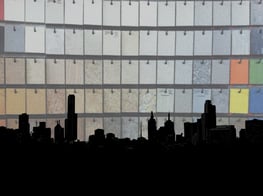To wrap up this year’s National Energy Awareness Month, I want to reflect on a few milestones that celebrate the progress of energy efficiency in our built environment. On any given day, our architects, engineers, and building science specialists work on complex projects that integrate a wide range of

systems. Each discipline has to manage codes, policies, professional practices, and client demands that can change during the course of a project. We pride ourselves in being able to drive these advancements, not just keep up with them.
The timeline below is a 40 year snapshot of the progress made in our building environment. Each milestone, large and small, builds on the others and reinforces the foundation for our future work. Enjoy!
1973
OAPEC Oil Embargo
The American Institute of Architects (AIA) forms the AIA Energy Committee
1974
Wayne Schick and his team at the University of Illinois at Urbana-Champaign developed a super insulated building prototype called the ‘Lo-Cal house’. In addition to increased insulation in the building’s envelope, this project utilized air-to-air heat exchangers and documented the benefits of air-tight construction.
1976
The U.S. Department of Energy‘s Weatherization Assistance Program was created by the Energy Conservation and Production Act of 1976. This program promoted the benefits of reducing air leakage in building envelopes.
1977
The US Department of Energy (DOE) creates the Solar Energy Research Institute.
The Saskatchewan Conservation House in Regina, Canada was built to showcase the ability of super-insulated envelope construction. It provided space heating through ventilation air and a minimized air-to-air heat exchange system.
1979
The Carter administration approves the installation of 32 solar panels on the White House.
Edward Mazria publishes The Passive Solar Energy Book.
1982
The first small-scale prototype solar draft tower was built in Manzanares, Spain.
1986
The Reagan administration removes the solar panels from the White House.
1988
Bo Adamson and Wolfgang Feist begin to develop European ‘Passive Haus’ standard
1989
Bob Berkebile and the AIA create the AIA Committee on the Environment (AIA/COTE)
1990
The first European Passive Haus is built in Kranichstein, Germany. This house demonstrated a 60-70% reduction in overall energy use as compared to a code baseline building at that time. At the same time, the BREEAM building energy efficiency rating system is launched in Europe. Today this program has over 250,000 registered buildings in its portfolio.
1991
The Solar Energy Research Institute becomes the National Renewable Energy Laboratory (NREL)
1992
The Environmental Protection Agency (EPA) Act of 1992 is written.
The Energy Star program is launched by the U.S. Environmental Protection Agency (EPA).
1993
United States Green Building Council (USGBC) is formed.
The ‘Greening of the White House’
1996
Passivhaus-Institut was founded in Darmstadt, Germany.
1997
The Whole Building Design Guide is developed through a collaborative effort between federal agencies, private sector companies, non-profit organizations and educational institutions. It is managed by the National Institute of Building Sciences. (NIBS)
2000
The USGBC launches its Leadership in Energy and Environmental Design (LEED) program.
2002
The World Green Building Council is created by David Gottfried, the founder of the USGBC.
The first DOE Solar Decathlon is held on the Mall in Washington, DC.
Architecture 2030 was created in conjunction with Edward Mazria to push building construction toward carbon neutrality (using no fossil fuel GHG emitting energy to operate) by 2030.
2003
The Klingenberg/Smith house is constructed in Urbana, IL. Considered the first U.S built home to meet the German PassivHaus standard
2006
The Living Building Challenge is introduced by the Cascadia Green Building Council
2007
The Passive House U.S. (PHIUS) program is started in Urbana, IL.
2009
The International Living Building Institute is created by the Cascadia Green Building Council to manage the Living Building Challenge program
2010
The International Green Construction Code v1.0 is released.
2011
The Obama administration approves the installation of solar photovoltaic (PV) panels on the White House.
2013
The first transcontinental solar powered flight is completed in the United States without a drop of fuel.

